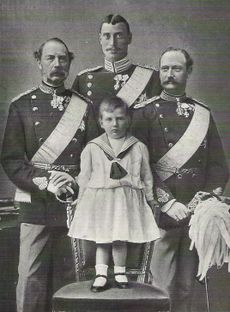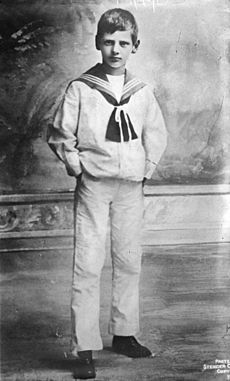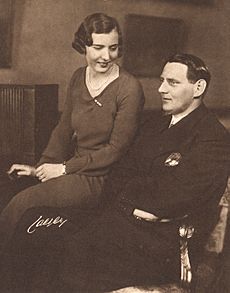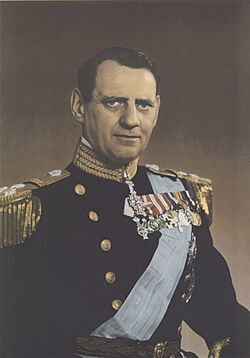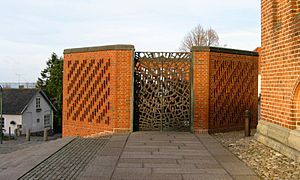Frederik IX facts for kids
Quick facts for kids Frederik IX |
|
|---|---|

A photo of Frederik IX, around 1970
|
|
| King of Denmark | |
| Reign | 20 April 1947 – 14 January 1972 |
| Predecessor | Christian X |
| Successor | Margrethe II |
| Born | 11 March 1899 Sorgenfri Palace, Kongens Lyngby, Denmark |
| Died | 14 January 1972 (aged 72) Municipal Hospital, Copenhagen, Denmark |
| Burial | 24 January 1972 Roskilde Cathedral, Roskilde, Denmark |
| Spouse | |
| Issue |
|
| House | Glücksburg |
| Father | Christian X of Denmark |
| Mother | Alexandrine of Mecklenburg-Schwerin |
| Religion | Church of Denmark |
| Signature | |
Frederik IX (born Christian Frederik Franz Michael Carl Valdemar Georg; 11 March 1899 – 14 January 1972) was the King of Denmark from 1947 to 1972.
Frederik was born into the House of Glücksburg, a royal family. He was the first child of Prince Christian and Princess Alexandrine of Mecklenburg-Schwerin. His father later became King Christian X. Frederik became the crown prince when his father became king in 1912.
As a young man, he studied at the Royal Danish Naval Academy. In 1935, he married Princess Ingrid of Sweden. They had three daughters: Margrethe, Benedikte, and Anne-Marie. During World War II, when Nazi Germany occupied Denmark, Frederik acted as a temporary ruler for his father from 1942 to 1943.
Frederik became king after his father died in April 1947. During his time as king, Danish society changed a lot. The country developed a strong social support system, and more women started working outside the home. These changes meant the monarchy also had to adapt. Frederik died in 1972, and his oldest daughter, Margrethe II, became queen.
Contents
Birth and Early Life
Prince Frederik was born on 11 March 1899. He was born at Sorgenfri Palace, his parents' country home near Copenhagen, Denmark. At the time, his great-grandfather, King Christian IX, was ruling Denmark.
Frederik's father was Prince Christian (who later became King Christian X). His mother was Alexandrine of Mecklenburg-Schwerin. Frederik was baptized on 9 April 1899. He had many godparents, including his great-grandfather King Christian IX.
Frederik's only brother, Knud, was born a year after him. The royal family lived in different palaces, including Amalienborg Palace in Copenhagen and Sorgenfri Palace. They also had a summer home called Marselisborg Palace.
Becoming Crown Prince
When Frederik's great-grandfather, King Christian IX, died in 1906, his grandfather became King Frederik VIII. This meant Frederik's father became the crown prince, and Frederik was now second in line to the throne.
Just six years later, in 1912, King Frederik VIII died. Frederik's father then became King Christian X, and Frederik officially became the crown prince. In 1918, Iceland became its own country but still shared the same king with Denmark. So, Frederik also became the crown prince of Iceland. However, Iceland later became a republic in 1944, so he never became king of Iceland.
Frederik chose to join the navy, which was a new path for a Danish royal. He studied at the Royal Danish Naval Academy. Before becoming king, he reached a high rank as a naval officer. He also loved music and was a talented piano player and conductor.
Marriage and Family Life
In 1935, a few days after his 36th birthday, Frederik announced his engagement to Princess Ingrid of Sweden. Ingrid was the daughter of Crown Prince Gustaf Adolf (who later became King Gustaf VI Adolf of Sweden).
Frederik and Ingrid were related to each other in several ways, as was common among European royal families. They married in Stockholm, Sweden, on 24 May 1935. Their wedding was a very big event, with many royal guests from different countries.
After their wedding, the couple lived at Frederik VIII's Palace in Copenhagen. They also had a summer home called Gråsten Palace.
Frederik and Ingrid had three daughters:
- Queen Margrethe II, born in 1940. She married Count Henri de Laborde of Monpezat and has two sons.
- Princess Benedikte, born in 1944. She married Richard, 6th Prince of Sayn-Wittgenstein-Berleburg and has three children.
- Princess Anne-Marie, born in 1946. She married King Constantine II of Greece and has five children.
Becoming King and His Reign
From 1942 to 1943, Frederik served as a temporary ruler because his father was unwell after falling from his horse.
On 20 April 1947, Frederik's father, King Christian X, died. Frederik then became the new king. The Prime Minister of Denmark announced him as king from the balcony of Christiansborg Palace.
Frederik IX's time as king saw many big changes in Denmark. The country moved from being mostly agricultural to a modern society. The government also expanded its social welfare programs, helping more people. In the 1960s, the economy grew, and many more women joined the workforce. These changes meant that the monarchy also had to adapt to a modern country.
In 1948, the Faroe Islands gained more self-governance within the Danish kingdom.
Changes to the Rules of Succession
King Frederik IX and Queen Ingrid did not have any sons. According to the old rules, Frederik's younger brother, Prince Knud, would have become king.
However, in 1953, a new law was passed about who could inherit the throne. This new law allowed daughters to become queen if there were no sons. Because of this change, Frederik's oldest daughter, Margrethe, became the next in line to the throne.
Death and Funeral
After giving his New Year's speech in late 1971, King Frederik IX became ill. He suffered a heart attack and was taken to the hospital on 3 January 1972. His health got worse, and he died on 14 January 1972, surrounded by his family.
After his death, the King's coffin was taken to his home at Amalienborg Palace. It was then moved to a chapel at Christiansborg Palace, where people could come to pay their respects.
The funeral took place on 24 January 1972. It was a large ceremony. The coffin was carried out of the chapel by members of the Royal Life Guards. It was then placed on a special carriage pulled by sailors and escorted by honor guards from different countries.
The coffin traveled by train to Roskilde. In Roskilde, it was carried through the city to Roskilde Cathedral. Most past Danish rulers were buried inside the cathedral. However, King Frederik IX had wished to be buried outside.
Succession and Legacy
Frederik IX was succeeded by his eldest daughter, Queen Margrethe II. She later stepped down from the throne on 14 January 2024, exactly 52 years after her father's death and her own accession.
Queen Ingrid, Frederik's wife, lived for 28 years after him. She died in 2000 and was buried next to him outside Roskilde Cathedral.
On 20 April 1982, a statue of King Frederik IX was unveiled in Copenhagen. He is shown wearing an admiral's uniform. This was done to mark 35 years since he became king and 10 years since his death.
A mountain range in Greenland was named the Crown Prince Frederik Range after him. This happened in 1934.
A Royal Dish
In the city of Sønderborg in southern Denmark, there is a special dish named after King Frederik IX. It is called "Kong Fiddes livret," which means "King Frederik's Favorite." "Fidde" is a common nickname for people named Frederik in that area.
This dish was supposedly served to King Frederik IX on his birthday at Gråsten Palace. It is made with strips of flank steak in a creamy sauce with paprika and curry. It is served with French fries, boiled potatoes, beetroot, boiled eggs, and fresh onions.
Honours and Appointments
King Frederik IX received many honours and military appointments throughout his life.
- Danish Honours
- Knight of the Order of the Elephant, the highest Danish order.
- Grand Commander of the Order of the Dannebrog.
- Received various Danish medals for service and anniversaries.
- Foreign Honours
He also received many honours from other countries, including:
- Grand Cross of the Order of the Falcon from Iceland.
- Grand Cordon of the Legion of Honour from France.
- Knight of the Order of the Seraphim from Sweden.
- Knight of the Order of the Garter from the United Kingdom.
- Honorary Military Appointments
Frederik IX also held honorary positions in British military regiments:
- From 1947 to 1961, he was the Colonel-in-Chief of the Buffs (Royal East Kent Regiment).
- From 1961 to 1966, he was the Colonel-in-Chief of the Queen's Own Buffs, The Royal Kent Regiment.
- From 1966 to 1972, he was the Colonel-in-Chief of the Queen's Regiment.
Images for kids
See also
 In Spanish: Federico IX de Dinamarca para niños
In Spanish: Federico IX de Dinamarca para niños


